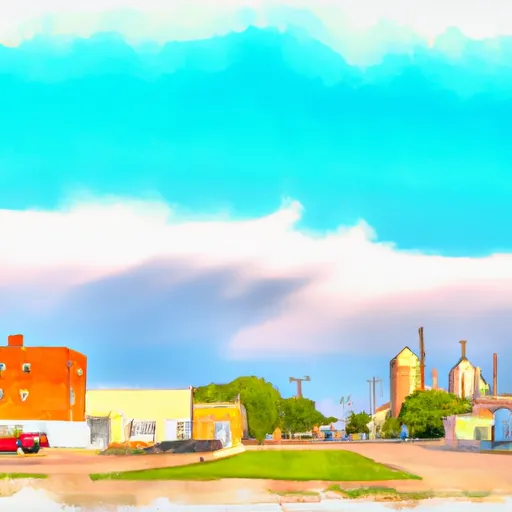-
 Snoflo Premium
Snoflo Premium
Get unlimited access to all our content
With no Ad interruptions! - Start Your Free Trial Login with existing account
Udall
Eden Index
Climate
8.3
•
Recreation
5.1
•
Community
2.1
•
Safeguard
5.6/10

Udall, Kansas is a small town located in Cowley County, in the southern part of the state. The climate in Udall is classified as humid continental, characterized by hot summers and cold winters. Summers tend to be hot and humid with temperatures often reaching the 90s Fahrenheit (32°C), while winters are cold and can see temperatures dropping below freezing.
Udall lies near the confluence of the Walnut and Arkansas Rivers, making hydrology an important aspect of the area. The rivers provide water for irrigation and contribute to the region's agricultural activities. However, Udall has also experienced flooding in the past due to its proximity to these rivers.
Outdoor recreation opportunities in Udall include various activities centered around the natural surroundings. Fishing enthusiasts can enjoy casting their lines in the Walnut River, which is known for its diverse fish population. The nearby Cowley State Fishing Lake is another popular spot for fishing and boating. Additionally, residents and visitors can explore the Walnut River Greenway, a scenic hiking and biking trail that stretches for miles along the river, offering opportunities for outdoor exercise and wildlife observation.
What is the Eden Index?
The Snoflo Eden Index serves as a comprehensive rating system for regions, evaluating their desirability through a holistic assessment of climate health, outdoor recreation opportunities, and natural disaster risk, acknowledging the profound impact of these factors on livability and well-being.
Climate Health Indicator (CHI): 8.3
Udall receives approximately
883mm of rain per year,
with humidity levels near 80%
and air temperatures averaging around
14°C.
Udall has a plant hardyness factor of
6, meaning
plants and agriculture in this region thrive during a short period during spring and early summer. Most
plants will die off during the colder winter months.
By considering the ideal temperature range, reliable water supplies, clean air, and stable seasonal rain or snowpacks, the Climate Health Indicator (CHI) underscores the significance of a healthy climate as the foundation for quality living.
A healthy climate is paramount for ensuring a high quality of life and livability in a region, fostering both physical well-being and environmental harmony. This can be characterized by ideal temperatures, reliable access to water supplies, clean air, and consistent seasonal rain or snowpacks.
Weather Forecast
Streamflow Conditions
Middle Arkansas
Area Rivers
Middle Arkansas
Snowpack Depths
Middle Arkansas
Reservoir Storage Capacity
Middle Arkansas
Groundwater Levels
Recreational Opportunity Index (ROI): 5.1
The Recreational Opportunity Index (ROI) recognizes the value of outdoor recreational options, such as parks, hiking trails, camping sites, and fishing spots, while acknowledging that climate plays a pivotal role in ensuring the comfort and consistency of these experiences.
Access to outdoor recreational opportunities, encompassing activities such as parks, hiking, camping, and fishing, is crucial for overall well-being, and the climate plays a pivotal role in enabling and enhancing these experiences, ensuring that individuals can engage in nature-based activities comfortably and consistently.
Camping Areas
| Campground | Campsites | Reservations | Toilets | Showers | Elevation |
|---|---|---|---|---|---|
| Perry Lake | 10 | 1,105 ft | |||
| McFadden Cove - Kaw Lake | None | 1,025 ft | |||
| Coon Creek Cove - Kaw Lake | None | 1,045 ft | |||
| Lake Ponca | None | 1,012 ft | |||
| Lake McMurtry East | None | 985 ft | |||
| Osage Cove - Kaw Lake | None | 1,123 ft | |||
| Lake McMurtry West | None | 993 ft | |||
| Bell Cow Lake and Equestrian | 60 | 928 ft | |||
| Milford State Park | 250 | 1,213 ft | |||
| Lake Carl Blackwell | 200 | 988 ft |
Catastrophe Safeguard Index (CSI):
The Catastrophe Safeguard Index (CSI) recognizes that natural disaster risk, encompassing floods, fires, hurricanes, and tornadoes, can drastically affect safety and the overall appeal of an area.
The level of natural disaster risk in a region significantly affects safety and the overall livability, with climate change amplifying these risks by potentially increasing the frequency and intensity of events like floods, fires, hurricanes, and tornadoes, thereby posing substantial challenges to community resilience and well-being.
Community Resilience Indicator (CRI): 2.1
The Community Resilience Indicator (CRI) recognizes that education, healthcare, and socioeconomics are crucial to the well-being of a region. The CRI acknowledges the profound impact of these elements on residents' overall quality of life. By evaluating educational resources, healthcare accessibility, and economic inclusivity, the index captures the essential aspects that contribute to a thriving community, fostering resident satisfaction, equity, and social cohesion.

